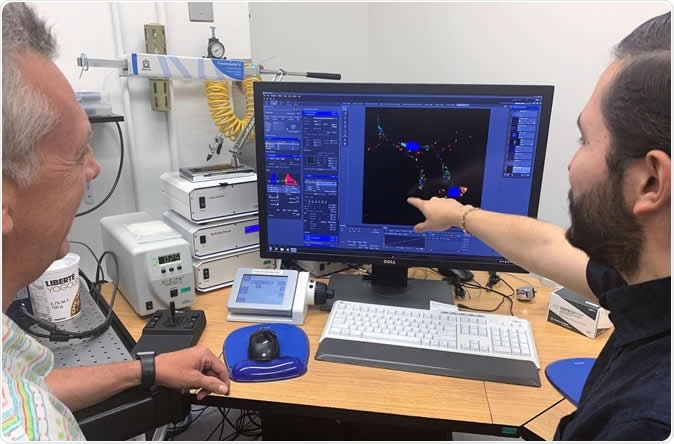Researchers from the Institut National de la Recherche Scientifique (INRS) have made a breakthrough in understanding the reason behind the virulence of leishmania parasite. The leishmania parasite is responsible for causing leishmaniasis which affects over 12 million people across the globe and is a chronic parasitic disease.

Leishmania parasites which cause leishmaniasis, 3D illustration - Credit: Kateryna Kon / Shutterstock
According to the experts leishmania is capable of damaging the immune system especially the macrophage defence system of the body of the host. This led to cutaneous or skin or systemic meaning whole body leishmaniasis. The researchers explained that the actual underlying mechanism by which this parasite affects the macrophages has been unknown until now. The study titled, “The host cell secretory pathway mediates the export of leishmania virulence factors out of the parasitophorous vacuole,” was published in the latest issue of the journal PLOS Pathogens.

Albert Descoteaux and Guillermo Arango Duque from the Institut National de la Recherche Scientifique (INRS) in Quebec, Canada, have made a scientific breakthrough regarding the virulence strategy employed by the Leishmania parasite to infect cells of the immune system. Image Credit: Communications, Institut National de la Recherche Scientifique (INRS)
The team led by INRS professor Albert Descoteaux worked alongside researchers from McGill University, Université de Montréal, and Tohoku University to discover the molecular mechanism that helps the parasite attack the immune system of the hosts. They explain that the macrophages or the first line defence cells of the body contain certain intracellular transport systems that help them transport various nutrients and other material inside and out. These transport systems are utilized by the leishmania parasite to transfer their virulence factors, found the researchers. Descoteaux explained in a statement, “It's like there's a train travelling among the different intracellular compartments that the parasite boards to deliver its virulence factors inside the infected cell. Our study sheds new light on the pathogenesis of infection.”
The team explains that leishmania parasite infects the phlebotomine sand fly. When this infected fly bites mammalian hosts or humans, the infection is transmitted. Each parasite has two main molecules on its surface that cause it to infect the host cells. These virulence factors are called “GP63 metalloprotease and lipophosphoglycan (LPG),” wrote the researchers. Once the parasite infects the macrophage of the host cell, the leishmania enters a vacuole called the parasitophorous vacuole. A vacuole is a sac like organelle within the cell. The parasite sort of captures the vacuole for its transport with help of the virulence factors and the vacuole in turn protects the parasite like a bubble around it. This vacuole allows the parasite to escape the defence system of the body as well. Within the host cell, the parasite thus finds a place where it can safely replicate and multiply.
The question that this study answers is the mechanism by which the parasite’s virulence factors enter the macrophages and reach their targets. Guillermo Arango Duque, a PhD scholar guided by Professor Descoteaux is the first author of this study. He explained, “Most research teams study the impacts of virulence factors, but until now no one understood how leishmania was able transfer virulence factors from the vacuole to the cytoplasm of the infected cell. That's what we've just shown with our work.” He added, “We discovered that leishmania co-opts the macrophage's membrane fusion machinery to export virulence factors out of the vacuole.”
Authors write, “Leishmania promastigotes are internalized by phagocytes into a highly modified phagosome that promotes parasite growth and differentiation into the amastigote form. Leishmania employs surface-bound glycoconjugates such as the GP63 metalloprotease and lipophosphoglycan to subvert the phagosome’s microbicidal potential.”
The team noted that the parasite is capable of transferring its virulence factors – the GP63 and LPG molecules to the other side of the vacuole membrane that they have hacked into. From there the virulence factors have been shown to affect the other compartments of the cell as well. For example these factors then reached the endoplasmic reticulum (ER) of the cell that forms a large part of the intracellular organs system of the cell. The ER is also linked with other parts of the intracellular structure and thus the virulence factors can spread easily via the ER.
The team used effective genetic tracking methods to look at the movements of these virulence factors within the cell and found a unique method of stopping the movement of these virulence factors within the macrophages. They stopped the formation of two host proteins called the sec22b and syntaxin-5. Once these proteins were blocked the movement of the virulence factors via the ER also effectively stopped, the team explained. These two proteins - sec22b and syntaxin-5 – are the key molecules that help in movement of molecules across the ER, they added.
Authors concluded, “knockdown ER/ERGIC-resident membrane fusion regulators Sec22b and syntaxin-5 revealed that these host molecules were essential to the phagosomal egress of leishmania virulence factors. These findings provide new insight into how leishmania sabotages the host cell endomembrane system for its own benefit.”
Professor Descoteaux explained, “To fully understand what enables the compartment where leishmania replicates to connect with other compartments of the infected host cell is a major step forward. This pathway could also be exploited by other intracellular microorganisms such as Mycobacterium tuberculosis, which is the agent of tuberculosis, or Legionella pneumophila, which causes Legionnaires' disease.” The researchers thus have latched on to the therapeutic potential of blocking this important pathway to stop the spread of this parasitic infection within the body and its replication.
The study was funded by the Canadian Institutes of Health Research (CIHR).
Journal reference:
The host cell secretory pathway mediates the export of Leishmania virulence factors out of the parasitophorous vacuole, Guillermo Arango Duque, Armando Jardim, Étienne Gagnon, Mitsunori Fukuda, Albert Descoteaux, Published: July 29, 2019, https://doi.org/10.1371/journal.ppat.1007982, https://journals.plos.org/plospathogens/article?id=10.1371/journal.ppat.1007982